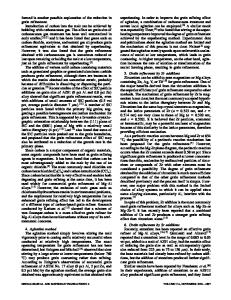The grain refinement mechanism of electrodeposited copper
- PDF / 2,395,651 Bytes
- 11 Pages / 584.957 x 782.986 pts Page_size
- 69 Downloads / 330 Views
Microstructure features of five electrodeposited coppers with different grain sizes were systematically characterized by using transmission electron microscopy (TEM) observations and x-ray diffraction (XRD) analysis. Based on the experimental observations, two mechanisms for the grain refinement in electrodeposited copper were identified: (i) twin–twin intersection can directly create grains with large-angle boundaries as small as 10 nm and (ii) grains can also be refined via formation of dislocation cells, transformation of dislocation cell walls into sub-boundaries with small misorientations, and evolution of sub-boundaries into highly misoriented grain boundaries. Besides, dislocations are also effective to cut twin lamellas into pieces and make twin boundaries curved and round. I. INTRODUCTION
Nanocrystalline (nc) metals have been the subjects of worldwide research over the past two decades because of their unique properties compared with their coarsegrained counterparts.1–4 There are several approaches that are widely used to synthesize nc metals. These approaches had been classified into bottom-up, such as inert gas condensation and mechanical alloying, and topdown, such as severe plastic deformation and surface mechanical attrition treatment. The nanocrystallization process is a bottom-up method that is easy to be understood; that is, a lot of nc particles are reunited to build a large bulk nc metal. Nc metals with small grain size and narrow grain size distribution were synthesized by this method.5–8 However, pre-existing flaws, such as porosity, weak interparticle bonding, and chemical impurities, usually accompanied these metals. The nc metals can also be obtained by subdividing coarse grains into nanograins, which is the top-down way. Severe plastic strain leads to a high density of dislocations. Development of these dislocation configurations gradually results in subdivision of original grains by forming individual dislocation cells. As plastic deformation increases, these dislocation cells are transformed into sub-boundaries and then grain boundaries.9,10 Generally, only ultrafinegrained metals can be obtained with this method, because the structural refinement can be saturated with increasing strain.10–12 It has been shown that surface mechanical attrition treatment (SMAT) is an effective method to subdivide coarse grains into nanoscale grains by severe plastic deformation with very high stain a)
Address all correspondence to this author. e-mail: [email protected] DOI: 10.1557/JMR.2009.0372
3226
http://journals.cambridge.org
J. Mater. Res., Vol. 24, No. 10, Oct 2009 Downloaded: 12 Mar 2015
rate.13–15 However, bulk nc metals cannot be fabricated with this method because the nanoscale grains can only be obtained in the top surface layer (
Data Loading...











